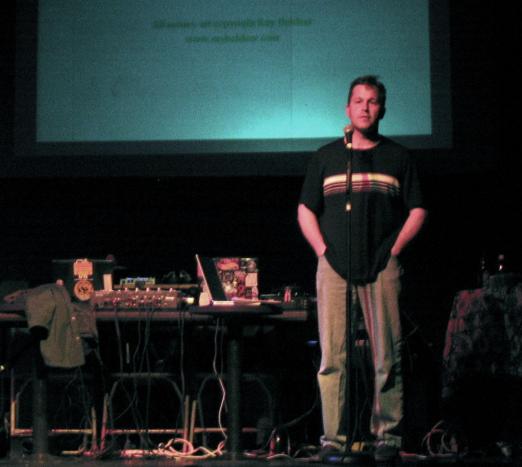 The first artist is Ray Beldner, who teaches a course at St. Mary's College on Pranking as a means of Culture Jamming (read article here). One of the assignments of the class is to create and submit false press releases in an attempt to get the news media to pick up on and publicize a false story -- essentially pranking to produce some sort of "social change":
The first artist is Ray Beldner, who teaches a course at St. Mary's College on Pranking as a means of Culture Jamming (read article here). One of the assignments of the class is to create and submit false press releases in an attempt to get the news media to pick up on and publicize a false story -- essentially pranking to produce some sort of "social change":"Beldner said he wanted to teach students how to bring issues to the public eye using creative methods. His course syllabus defines 'culture jamming' as 'a resistance movement to the perceived hegemony of popular culture.' 'These are serious-minded pranks,' he said. 'It's not just about people goofing around.'"
The concept of culture jamming is a broad one, far too broad to analyze here (see the wikipedia article for more info).
 However, an element that seems to creep into culture jamming, at least the strain propogated by Beldner in this class, is social revolution by destruction, or at least deconstruction, of institutions. Interestingly, Beldner does this in his art by taking objects and dramatically changing the context in which they are viewed. He created one series composed of paper money mutilated to produce other images -- often ironic images that lampoon consumerism and capitalistic interests. For instance, a portrait of Chairman Mao (copied after Andy Warhol's portrait) created from shredded dollar bills. (I must admit, I thought this piece to be both technically impressive and pretty darn funny)
However, an element that seems to creep into culture jamming, at least the strain propogated by Beldner in this class, is social revolution by destruction, or at least deconstruction, of institutions. Interestingly, Beldner does this in his art by taking objects and dramatically changing the context in which they are viewed. He created one series composed of paper money mutilated to produce other images -- often ironic images that lampoon consumerism and capitalistic interests. For instance, a portrait of Chairman Mao (copied after Andy Warhol's portrait) created from shredded dollar bills. (I must admit, I thought this piece to be both technically impressive and pretty darn funny)The class on Pranking is but an extension of his other work -- subversive and deconstructing the target of the prank. Indeed, one could imagine that the very existence of the class is but another artistic subversion. Imagine the parent looking over his child's syllabus saying "I paid how many thousand dollars per credit hour for you to take a class in pranks?" That picture alone conveys the serious minded institutional subversion that Beldner seems to be after.
 The second artist is Makoto Fujimura, (read the profile from World Magazine, or see his website). A Christian, Fujimura strives to portray the redemtive in his art. This doesn't mean that he only does naturalistic scenes -- quite the contrary, he is a celebrated abstract artist. He is also the founder of theInternational Arts Movement, an organization to help advance Christian worldview thinking in the arts.
The second artist is Makoto Fujimura, (read the profile from World Magazine, or see his website). A Christian, Fujimura strives to portray the redemtive in his art. This doesn't mean that he only does naturalistic scenes -- quite the contrary, he is a celebrated abstract artist. He is also the founder of theInternational Arts Movement, an organization to help advance Christian worldview thinking in the arts. His studio is located in the shadow of ground zero in New York. After the whirlwind of wrath that was 9/11, Fujimura was homeless, his apartment building shut down by the devastation. His children were out of school for months. The World Magazine story tells his response:
"He wrestled with the artistry of the terrorists, the penchant for destruction in his own heart, and the idols to modernism now fallen in his backyard. Then came the seed of an idea, and he wrote an e-mail to friends: 'Create we must, and respond to this dark hour. The world needs artists who dedicate themselves to communicate the images of Shalom. Jesus is the Shalom.'
Tribeca Temporary grew from that seed, a 'Ground Zero teahouse' and a community space for artists displaced by the attacks. With fellow painter Hiroshi Senju, Mr. Fujimura turned a studio into a place for restoration and healing from spiritual as well as artistic losses where, Mr. Fujimura said, 'beauty too is defined as a participant in the suffering of the world.'
Faced every day with the smells and sounds of Ground Zero, and at nightfall with its floodlights, Mr. Fujimura found more and more that the way to Shalom was through refining fires. In the poetry of T.S. Eliot and Dante he fixed on the line, 'The fire and the rose are one,' and launched into his own 'knot of fire' with imagery that, too, moved beyond destruction to redemption. Instead of the destruction in his neighborhood, he focused on what he calls the 'sacrificial art' of firefighters who protected his children. 'Rescue workers imagine saving lives, a beautiful and relevant use of imagination. The artist who tries to be vulnerable will intentionally suffer,' he said."
Now take note -- it seems the artists are superficially on the same page: "the way to Shalom was through refining fires" sounds like it could promote the kind of culture jamming Beldner advocates. However, herein lies the difference -- Beldner seeks to set fires whereas Fujimura seeks to redeem them after they've been set. Please don't get me wrong here -- I'm not making any kind of implicit link between Beldner's advocacy of pranking and the 9/11 terrorists -- their motivations and methodologies vary widely.
That said, we can contrast Beldner with Fujimura and see a chasm of difference -- one acting subversively, one acting to heal.
Fujimura sees us as living out Jeremiah 29 -- building houses, settling down, and praying and working for the welfare in the city in which we've found ourselves. Being a creative and positive presence in the middle of a hurting and broken world. And therein lies all the difference.
Soli Deo Gloria
Russell
PS -- a special thanks to Presbyweb and Blogs 4 God, which linked to the posts on Narnia -- they helped push the Eagle and Child into a record number of visits -- pushing us over 1000 for the month of December (and still climbing). Thanks to all who have visited -- come back soon!



